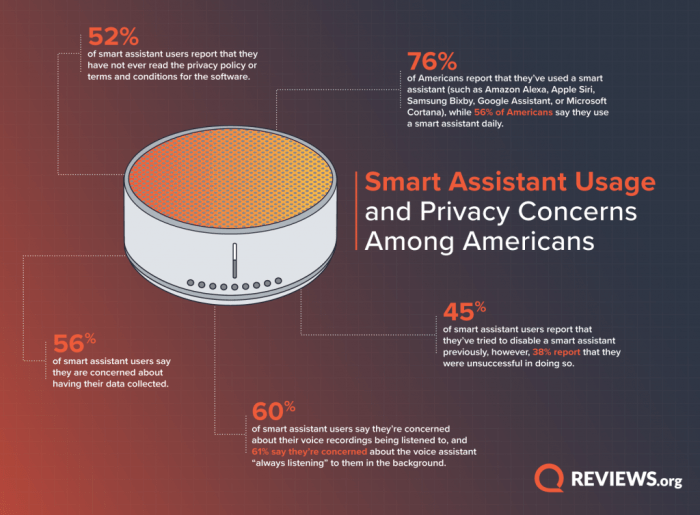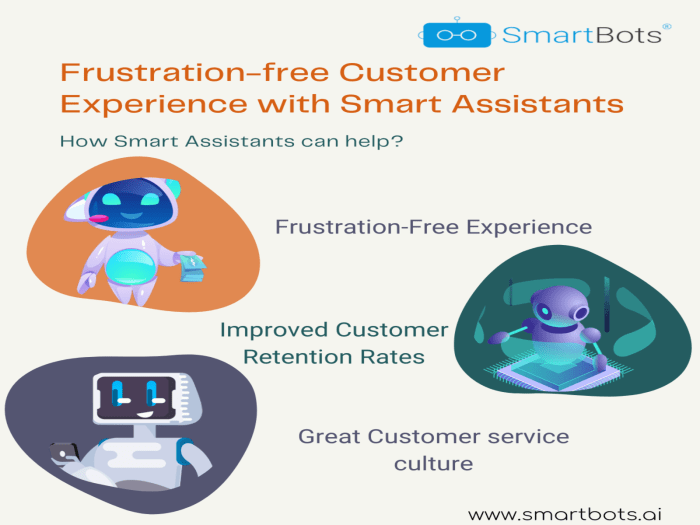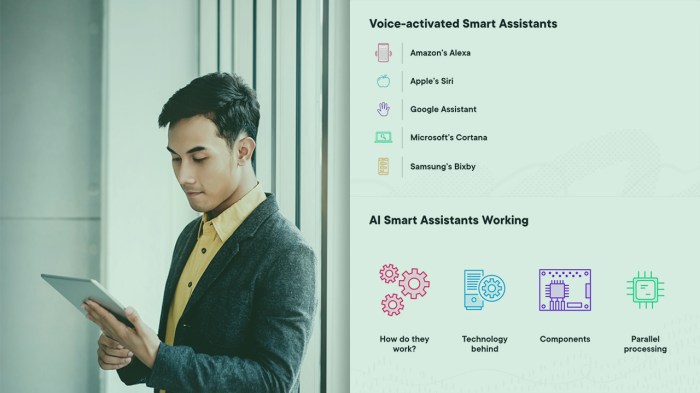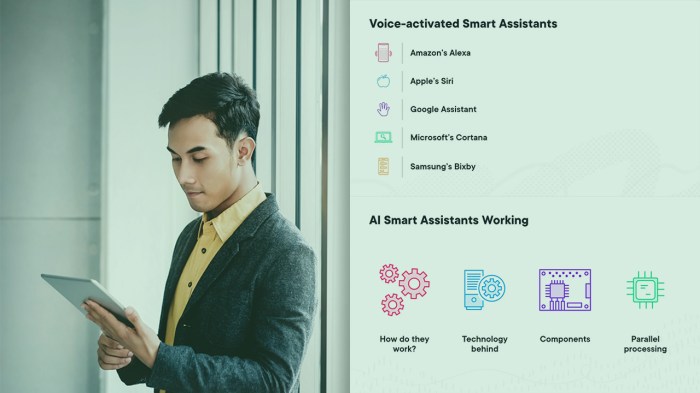Hidden features and functionalities of smart assistants most people don’t know are surprisingly abundant. Beyond setting timers and playing music, these digital companions offer a wealth of advanced capabilities, from proactive assistance anticipating your needs to intricate customization options and seamless integration with other apps. Unlocking these hidden functionalities transforms your smart assistant from a simple tool into a powerful, personalized productivity partner. This exploration unveils the secrets to maximizing your smart assistant’s potential.
This article delves into the often-overlooked features of popular smart assistants like Google Assistant, Siri, and Alexa. We’ll explore advanced voice commands, customization techniques beyond the basics, integration with lesser-known apps, and crucial accessibility features. We’ll also address common troubleshooting issues and discuss the implications of data privacy in the context of highly personalized assistant usage. By the end, you’ll be equipped to harness the full power of your smart assistant.
Proactive Assistance Features
Smart assistants are evolving beyond simple command-response systems. Increasingly, they leverage sophisticated algorithms and user data to anticipate needs and offer assistance proactively, enhancing user experience and efficiency. This proactive approach represents a significant shift towards a more intuitive and personalized interaction model.
Proactive assistance relies on a combination of machine learning, natural language processing, and contextual awareness. Smart assistants analyze user behavior, location, calendar events, and other data points to identify potential needs or opportunities for helpful interventions. This allows them to provide relevant information or perform actions without explicit instruction, streamlining workflows and improving overall productivity.
Examples of Proactive Assistance Across Platforms
Several smart assistant platforms have implemented proactive features, each with unique strengths and limitations. These features range from simple reminders to complex task management and information delivery.
Google Assistant, for example, might proactively offer to navigate to a frequently visited location based on the time of day and your typical routine. Similarly, if you have a meeting scheduled, it might offer to start a timer or remind you to leave for the meeting considering traffic conditions. Siri, on Apple devices, can proactively suggest relevant information based on the context of your current activity. For instance, if you’re looking at a flight itinerary, Siri might proactively offer to add the flight to your calendar or provide real-time flight status updates. Amazon Alexa, while perhaps less sophisticated in its proactive capabilities compared to Google Assistant or Siri, can still provide reminders and notifications based on scheduled events or routines. It might remind you about upcoming appointments or offer to play your usual morning playlist based on the time of day.
Underlying Mechanisms of Proactive Assistance
The technological foundation of proactive assistance rests on several key components. Firstly, machine learning algorithms analyze user data to identify patterns and predict future needs. This involves processing vast quantities of data, including user interactions, calendar entries, location history, and app usage. Secondly, natural language processing (NLP) enables the assistant to understand user requests and context, even when these requests are implicit or unspoken. This allows the assistant to tailor its responses and suggestions to the specific needs of the user. Thirdly, contextual awareness plays a crucial role in determining the relevance and timeliness of proactive assistance. The assistant must understand the user’s current situation and environment to provide helpful and timely interventions. This requires integration with various sensors and data sources, such as location services, calendar apps, and smart home devices.
Comparison of Proactive Features
| Platform | Feature | Description | User Benefit |
|---|---|---|---|
| Google Assistant | Contextual Reminders | Reminds users about upcoming events based on location, time, and calendar entries. | Reduces the risk of missed appointments and improves time management. |
| Siri | Proactive Suggestions | Offers relevant information and actions based on the user’s current activity and context. | Streamlines workflows and provides quick access to relevant information. |
| Amazon Alexa | Routine-Based Reminders | Triggers reminders and notifications based on pre-defined routines and schedules. | Automates tasks and simplifies daily routines. |
| Google Assistant | Traffic Updates | Provides real-time traffic updates and suggests alternative routes if delays are anticipated. | Saves time and reduces stress during commutes. |
| Siri | Flight Status Updates | Provides real-time updates on flight status, including delays and gate changes. | Keeps users informed and reduces anxiety related to travel. |
| Amazon Alexa | Smart Home Control Suggestions | Suggests adjusting smart home devices based on time of day or user activity. | Improves energy efficiency and enhances home comfort. |
Customization and Personalization Beyond the Basics
Smart assistants offer a surprising depth of customization, far exceeding the simple voice selection and notification adjustments most users explore. Unlocking this potential allows for a truly personalized digital experience, tailored to individual needs and preferences, boosting both efficiency and user satisfaction. However, it’s crucial to understand the implications of this personalization regarding data privacy.
Advanced customization goes beyond superficial changes. It involves harnessing the assistant’s capabilities to create unique workflows and automate tasks in ways that significantly improve daily routines. This level of personalization requires a deeper understanding of the assistant’s features and a willingness to experiment with its various settings and functionalities.
Advanced Voice, Response, and Notification Customization, Hidden features and functionalities of smart assistants most people don’t know
Many smart assistants allow for granular control over voice profiles, enabling users to adjust speaking rate, pitch, and even accent to a degree. Beyond this, users can often customize responses, choosing from different levels of formality or even defining custom phrases for specific triggers. Notification settings can be finely tuned to filter out unwanted alerts and prioritize crucial information, potentially integrating with other apps for a more cohesive notification management system. For example, one could create a setting that only allows notifications from specific contacts during work hours, and another that summarizes all non-urgent notifications at the end of the day.
Creating Sophisticated Personalized Routines and Automations
Beyond simple timers, smart assistants enable the creation of complex routines triggered by various events. Imagine a routine that automatically adjusts your smart home lighting based on the time of day and the weather forecast, or one that sends a personalized message to a loved one at a specific time each day. These advanced automations can be linked to location data, calendar events, and other app integrations, creating a truly seamless and personalized experience. For instance, a routine could automatically start your favorite playlist when you connect to your home Wi-Fi, then dim the lights and turn on a specific smart device at sunset.
Data Privacy Implications of Highly Personalized Assistant Usage
The more personalized your smart assistant becomes, the more data it collects about your habits, preferences, and routines. This data, while used to improve your experience, also raises significant privacy concerns. It’s vital to understand what data is being collected, how it’s being used, and what security measures are in place to protect it. Regularly reviewing your assistant’s privacy settings and understanding the implications of granting various permissions are essential steps in maintaining your digital privacy. Consider using anonymization features where available and limiting the data shared with third-party apps.
Five Unique Ways to Personalize a Smart Assistant
The following list highlights some unique personalization options often overlooked by users:
- Create custom voice commands: Go beyond the default commands and define your own shortcuts for frequently used functions.
- Develop context-aware routines: Link routines to multiple triggers, such as time, location, and app usage, for more sophisticated automation.
- Integrate with lesser-known apps: Explore integrations with niche apps to unlock hidden functionalities and enhance personalization.
- Customize notification sounds and visual cues: Go beyond the default options and select sounds and visuals that are easily distinguishable and personally meaningful.
- Utilize the assistant’s developer tools (if available): Some assistants offer developer APIs or SDKs, allowing for highly advanced customization and integration with other services.
Hidden Settings and Configurations: Hidden Features And Functionalities Of Smart Assistants Most People Don’t Know

Smart assistants offer a wealth of customizable options beyond the readily accessible features. Delving into the hidden settings allows users to fine-tune their assistant’s behavior, prioritize privacy, and enhance security. This often involves navigating less-obvious menus or utilizing specific commands, which can significantly improve the user experience and control.
Accessing and modifying these advanced settings typically requires a willingness to explore beyond the standard interface. Many settings related to data usage, privacy, and security are deliberately tucked away to prevent accidental changes, ensuring user control over sensitive information. However, understanding where to look and what to change empowers users to tailor their smart assistant to their specific needs and comfort levels.
Accessing and Modifying Advanced Settings
Advanced settings related to data usage, privacy, and security are usually found within the assistant’s main settings menu. This often involves navigating to a section labeled “Privacy,” “Settings,” or “Account.” Once there, look for options related to data history, voice recording storage, location services, and third-party app permissions. These settings may include options to delete your voice history, disable location tracking, or control which apps have access to your assistant’s data. For example, on Google Assistant, one can find granular control over data history within the “My Activity” section of their Google account. Similarly, Amazon Alexa allows users to review and delete voice recordings through their Alexa app’s settings. Apple’s Siri, on the other hand, offers settings to manage location access and Siri suggestions within the device’s main settings menu.
Enabling or Disabling Specific Features
Enabling or disabling specific features often involves toggling switches or selecting options within the settings menus. For instance, you can typically disable features like proactive suggestions, personalized ads, or the ability for the assistant to access your contacts. These options are usually clearly labeled and accompanied by brief descriptions explaining their functionality. It is important to read these descriptions carefully before making changes to ensure you understand the implications. For example, disabling location services will prevent your assistant from providing location-based information, but it might also limit the functionality of certain apps or features that rely on location data. Conversely, enabling features like voice history will allow the assistant to learn from your interactions, potentially improving its accuracy and personalization, but it also means more data is stored about your usage.
Comparison of Privacy Settings Across Smart Assistant Platforms
A direct comparison of privacy settings across different smart assistant platforms reveals a variety of approaches to data handling. Google Assistant, for example, emphasizes personalization and often uses collected data to improve its services, offering granular controls over data retention and usage. Amazon Alexa focuses on convenience and user experience, providing tools to review and delete voice recordings, but perhaps with less granular control over other data types. Apple’s Siri prioritizes user privacy and emphasizes end-to-end encryption where possible, limiting data collection and providing straightforward options for disabling data sharing. While each platform offers features to manage privacy, the level of control and transparency varies significantly, requiring users to carefully review the specific settings available on each platform to make informed decisions about their privacy preferences.
Integration with Other Apps and Services
Smart assistants are not isolated entities; their true power lies in their ability to seamlessly integrate with a vast ecosystem of apps and services, extending their functionality far beyond their built-in capabilities. This integration allows for a more streamlined and efficient workflow, automating tasks and providing a centralized hub for managing various aspects of daily life. Many users only scratch the surface of this potential, limiting themselves to the most obvious integrations. Exploring the less-known connections can unlock significant productivity gains.
Smart assistants can connect with a wide range of applications, from productivity tools and calendar management systems to home automation platforms and specialized niche services. This interconnectedness allows for complex actions to be triggered through simple voice commands or automated routines. For instance, imagine setting up a routine where your smart assistant automatically adjusts your smart home’s lighting and temperature based on your calendar appointments, or sends a message to a colleague when a specific task is completed in a project management app. These seemingly small integrations can drastically reduce the time spent on mundane tasks and free up cognitive resources for more demanding activities.
Examples of Enhanced Productivity Through App Integration
The integration of smart assistants with various apps significantly boosts productivity and efficiency. For example, integrating with a task management app like Todoist or Asana allows users to add tasks hands-free, check off completed items, and receive reminders without ever touching their phone or computer. Similarly, linking a smart assistant to a calendar app enables effortless scheduling of meetings, setting reminders for appointments, and even providing real-time traffic updates to adjust departure times. Integration with email clients allows for dictation of emails, quick responses, and efficient filtering of messages, significantly reducing the time spent on email management. Furthermore, integrating with fitness trackers can provide personalized workout recommendations and track progress, motivating users to maintain a healthy lifestyle. Finally, connecting with smart home devices allows for comprehensive control of lighting, temperature, and security systems, all through voice commands, adding convenience and safety to daily routines.
Workflow of Integrating a Smart Assistant with a Specific App: Example with a Recipe App
The following flowchart illustrates the workflow of integrating a smart assistant (e.g., Google Assistant) with a recipe app (e.g., Paprika Recipe Manager).
[Imagine a flowchart here. The flowchart would begin with the user issuing a voice command such as “Find a chicken recipe using Google Assistant.” The flowchart would then show the smart assistant querying the Paprika Recipe Manager API. The API would return a list of relevant chicken recipes. The smart assistant would then present the user with a selection of recipes. The user could then select a recipe, and the smart assistant would display the recipe on a connected device (e.g., smart display). Finally, the flowchart would show the user being able to add ingredients to a shopping list or begin cooking the recipe based on the information provided.]
The process involves the smart assistant accessing the recipe app’s API (Application Programming Interface), which acts as a bridge for data exchange. The API allows the smart assistant to request information (e.g., recipes matching specific criteria) and receive data back in a structured format. This interaction enables a seamless and efficient workflow, enhancing the user experience by automating the search and retrieval of information. The success of this integration hinges on the recipe app offering a well-documented and accessible API, allowing for smooth communication between the two platforms.
Accessibility Features

Smart assistants offer a range of accessibility features designed to make them usable for individuals with a wide spectrum of abilities. These features often go unnoticed by those who don’t need them, but they are crucial for ensuring inclusivity and providing a positive user experience for everyone. Understanding and utilizing these features can significantly enhance the usability and accessibility of smart assistant technology.
Smart assistants incorporate several features to improve accessibility, primarily focusing on providing alternative input and output methods. Text-to-speech and voice control are two prominent examples. Text-to-speech converts on-screen text into audible speech, benefiting users with visual impairments or reading difficulties. Conversely, voice control allows users to interact with the assistant using their voice, eliminating the need for manual input via keyboard or touchscreen, beneficial for users with motor impairments or limited dexterity. These features, while seemingly simple, dramatically expand the accessibility of smart assistant technology.
Text-to-Speech Customization
The text-to-speech functionality in most smart assistants offers a degree of customization. Users can typically adjust the speaking rate, pitch, and even select from different voices. For example, a user might prefer a slower speaking rate for better comprehension, or a higher pitch for easier audibility. The availability of multiple voices allows users to choose a voice that is most comfortable and easily understood. Some assistants even offer the option to adjust pronunciation settings for specific words or phrases, improving accuracy and clarity. This level of personalization ensures that the text-to-speech experience is tailored to the individual user’s needs and preferences.
Voice Control Customization
Similarly, voice control features can also be customized to enhance usability. Users can often train their smart assistant to recognize their voice more accurately, reducing the frequency of misinterpretations. This is particularly helpful for users with speech impediments or those whose voices may vary in tone or clarity. Furthermore, many assistants allow users to adjust the sensitivity of voice recognition, minimizing accidental activations or false interpretations of commands. The ability to create custom voice commands can also be extremely beneficial, allowing users to streamline interactions with the assistant and perform complex tasks with minimal effort. For example, a user might create a custom command to initiate a specific sequence of actions, such as turning on the lights and setting the thermostat to a comfortable temperature.
Offline Capabilities and Limitations

Smart assistants, while incredibly powerful tools, are fundamentally reliant on internet connectivity for their full functionality. Their offline capabilities vary significantly depending on the platform and the specific features used. Understanding these limitations is crucial for managing expectations and effectively utilizing these digital helpers in situations with limited or no internet access.
Offline functionality is significantly reduced compared to online operation. While some basic commands might still work, complex tasks requiring real-time data retrieval or cloud processing will be unavailable. The core difference lies in the access to the vast databases and computational power that online servers provide. Offline modes essentially rely on locally stored data and a reduced set of pre-programmed responses.
Offline Functionality Comparison Across Platforms
The offline capabilities of smart assistants vary greatly across different platforms. Let’s compare three prominent examples: Google Assistant, Amazon Alexa, and Apple Siri. While specific features and their availability offline change with software updates, a general comparison provides insight into the differences.
Google Assistant offers a limited set of offline capabilities. Basic commands like setting timers or alarms generally function without an internet connection. However, more complex requests such as playing music from streaming services or making online searches are unavailable offline. The offline voice recognition is also less accurate than its online counterpart.
Amazon Alexa’s offline capabilities are somewhat more robust than Google Assistant’s, particularly for smart home device control. Many smart home functions, such as controlling lights or adjusting thermostats, can be performed offline if the devices are set up to work locally. However, playing music or accessing information through skills will require an internet connection. The accuracy of voice recognition also decreases in offline mode.
Apple Siri’s offline functionality is primarily limited to basic commands like setting reminders or making quick calculations. Complex tasks, such as sending messages or making calls through third-party apps, rely heavily on internet access. Offline voice recognition is available, but its accuracy is reduced, and the range of commands understood is significantly smaller than in online mode. Siri’s reliance on Apple’s ecosystem further restricts its offline performance.
Mastering the hidden features of your smart assistant unlocks a new level of efficiency and personalization. From proactive assistance to advanced voice controls and seamless app integrations, the capabilities extend far beyond the basics. By understanding these hidden functionalities and implementing the customization techniques discussed, you can transform your smart assistant into a truly indispensable tool, tailored to your specific needs and enhancing your daily life. Embrace the potential, and discover the power waiting to be unleashed.
Quick FAQs
What are the security risks associated with highly personalized smart assistants?
Highly personalized assistants collect significant amounts of personal data, increasing vulnerability to data breaches. Strong passwords, two-factor authentication, and regular security updates are crucial. Regularly review and adjust your privacy settings to minimize data collection.
How can I troubleshoot a smart assistant that’s not responding correctly?
Start by checking your internet connection. Then, try restarting your device and the smart assistant. If the problem persists, check for software updates and consider reinstalling the app. Contact the assistant’s support for further assistance.
Can I use my smart assistant offline?
Functionality is limited offline; many features require an internet connection. However, some basic commands, such as setting alarms, might still work. The specific offline capabilities vary depending on the assistant and device.
Examine how mobile vr headset reviews and comparisons 2024 can boost performance in your area.

